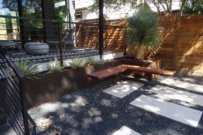Seems like someone already got to this one before me!

Large decomposed granite walkways have replaced the sea of Bermudagrass – bark chips also work great to keep down weeds, smells good too.
When we first moved in to our house in 2001, the backyard was completely covered with my “favorite” plant – bermudagrass. Well I am happy to report almost seven years later the only bermudagrass that still exists is at the front of my front yard between the sidewalk and the street. I am currently in the process of murdering it to make way for the plan I posted in my last entry.

The termination of my final patches of grass in my front yard. This combination of Sago Palm, Prickly Pearcactus and Yucca will look a lot better with boulders and decomposed granite around their base. The bermuda patch on the left is going to be really hard to get rid of around the Stargazer Lilly.
You can probably tell from the above pictures that I am not particularly organic in my approach to eradicating bermuda – in fact I am not organic at all. I am afraid that I reach for the Round Up (the very very strong kind) (super concentrate)) every time. In the old days I did try more organic practices, 20% vinegar, digging it up, weed barriers – the works, but the grass would always eventially return. It is relentless, it never sleeps, it is the Borg – (resistance is futile).
Because bermudagrass has specialized growth stems and a rapid growth rate, it is usually excellent at crowding out weeds. Also, this is the primary reason why bermuda grows back so well when it is injured. Underground shoots (rhizomes) and above ground runners (stolons) help bermudagrass “fill in fast” and I mean fast!. While these properties are highly beneficial for the plant, it is the reason why bermudagrass is considered an “invasive weed” where it is not wanted, like anywhere on my property.
Is there bermudagrass on Mars?

It has to have spread that far.
I am convinced the new NASA
expidition will find it
in the polar region.
Like almost all of our turfgrass species, bermudagrass is an introduced plant to the United States. The origin of the first introduction of bermudagrass most likely came from contaminated hay, which was used as bedding, when slaves were brought to America. Millions and millions of seeds were distributed initially across the eastern United States. Surviving plants then were able to make more seeds and so on, until my yard was full of the precious stuff.

Here is the front yard Vitex where a small bubble fountain is planned to go. Vitex wants to be a shrub and requires a LOT of pruning to raise up the canopy. It is in full bloom right now and is a great architectural “tree”. I have got rid of the weeds and grass in most of the front yard and covered it all in weed barrier and a good layer of decomposed granite.
Other Show-Offs in the yard right now:


Kidding!
I laughed so hard taking these pictures – look at them now! ahhaahaahaahaahaa! the first one I think has actually started to grow leaves again! ahhaaaaaa! what is it thinking?. If you didn’t catch the earlier blog these abominations started out as tomato plants. If you want my opinion, I think aliens abducted them, did the obligatory probe, fumbled around with their DNA, then teleported them silently back into my yard. What else could have cause such a cellular mutation?
Prostrate and upright rosemary spilling onto the sidewalk.
15′ in height.

left: Purple heart grows most vigorously and has the richest color in full sun, but it will tolerate some shade. right: This patch of Aloe Vera just gets larger each passing year. Aloe Vera has a long history of cultivation throughout the drier tropical and subtropical regions of the world, and it is a star when applied to burns.
Stay Tuned for:
“The Bermuda Triangle”
All material © 2009 for eastsidepatch. Unauthorized
intergalactic reproduction strictly prohibited, and
punishable by late (and extremely unpleasant)
14th century planet Earth techniques.







































































